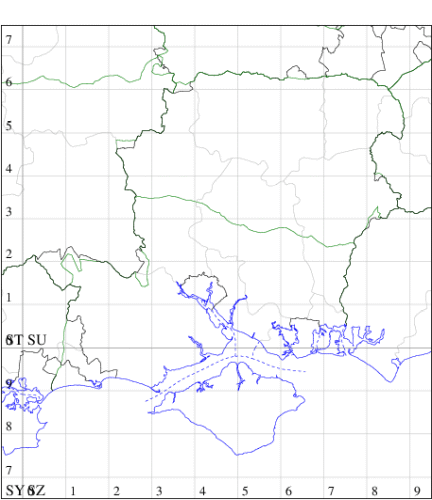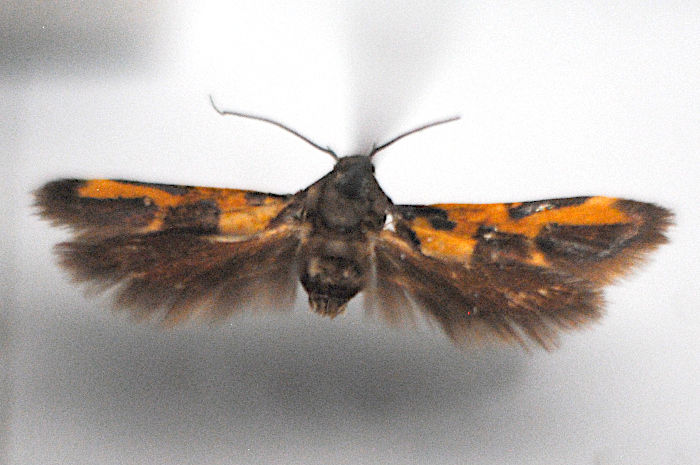Euclemensia woodiella
Checklist Number34.003 [B&F: 0901]
Verification
Record requires retention of specimen until confirmed, and may require dissection. Consult with CMR if unsure
Classification
| Family: | Cosmopterigidae |
| Subfamily: | Antequerinae |
| Genus: | Euclemensia |
| Species: | woodiella |
| Authority: | (Curtis, 1830) |
Extinct in the British Isles, formerly known from a single site in Lancashire, where three specimens were collected from dead wood on Kersal Moor. Not seen since, it is regarded as extinct, and is now known from just three museum specimens, in Manchester, London and Victoria, Australia.
The backstory for this species is an interesting tale. Robert Cribb, an amateur collector, collected a series of about fifty attractive yellow and brown moths from a rotting alder on Kersal Moor in Salford, near Manchester, in 1829. Not matching any known species, they were described as new to science by John Curtis, an entomologist who had been asked by Mr R. Wood, a friend of Cribb’s, to identify them. Unfortunately Curtis, being unaware of Cribb's involvement, named the moths as Pancalia woodiella in Wood's honour.
The relevant entry in British Entomology states: "P. Woodiella Curt. Brit. Ent 304—The only specimen I have seen of this beautiful Moth, which is larger than the [other Pancallia], is a female; it was taken on Kersall-moor the middle of last June by Mr. R. Wood, of Manchester, to whom I have the pleasure of dedicating it;—a most zealous and successful naturalist, to whose liberality I am indebted for this and many other valuable insects."
Enraged by this oversight, and by accusations of fraudulently passing off foreign moths as British, Cribb gave up collecting and left the rest of the collection with his landlady as security for a debt. Here the stories from Manchester University and The Australian Museum, Victoria differ as to whether it was Cribb's pub landlady or the landlady of his lodgings, but either way the result was the same. The debt was not paid on time and when Cribb went back for the moths, which he had already sold to another collector, his landlady had burnt them. Subsequent efforts by other collectors to find more of the moths were unsuccessful, and the three specimens left in existence are thought to be the only representatives of an extinct species.
Author's note: given the other four members of the genus Euclemensia, to which woodiella was moved in 1864, are North American, the suspicion has to be that the origin of this species in Britain was due to importation, which may explain why it has not been discovered subsequently.
Image by Andy Mabbett - Own work, CC BY-SA 4.0, https://commons.wikimedia.org/w/index.php?curid=72730997
The backstory for this species is an interesting tale. Robert Cribb, an amateur collector, collected a series of about fifty attractive yellow and brown moths from a rotting alder on Kersal Moor in Salford, near Manchester, in 1829. Not matching any known species, they were described as new to science by John Curtis, an entomologist who had been asked by Mr R. Wood, a friend of Cribb’s, to identify them. Unfortunately Curtis, being unaware of Cribb's involvement, named the moths as Pancalia woodiella in Wood's honour.
The relevant entry in British Entomology states: "P. Woodiella Curt. Brit. Ent 304—The only specimen I have seen of this beautiful Moth, which is larger than the [other Pancallia], is a female; it was taken on Kersall-moor the middle of last June by Mr. R. Wood, of Manchester, to whom I have the pleasure of dedicating it;—a most zealous and successful naturalist, to whose liberality I am indebted for this and many other valuable insects."
Enraged by this oversight, and by accusations of fraudulently passing off foreign moths as British, Cribb gave up collecting and left the rest of the collection with his landlady as security for a debt. Here the stories from Manchester University and The Australian Museum, Victoria differ as to whether it was Cribb's pub landlady or the landlady of his lodgings, but either way the result was the same. The debt was not paid on time and when Cribb went back for the moths, which he had already sold to another collector, his landlady had burnt them. Subsequent efforts by other collectors to find more of the moths were unsuccessful, and the three specimens left in existence are thought to be the only representatives of an extinct species.
Author's note: given the other four members of the genus Euclemensia, to which woodiella was moved in 1864, are North American, the suspicion has to be that the origin of this species in Britain was due to importation, which may explain why it has not been discovered subsequently.
Image by Andy Mabbett - Own work, CC BY-SA 4.0, https://commons.wikimedia.org/w/index.php?curid=72730997



